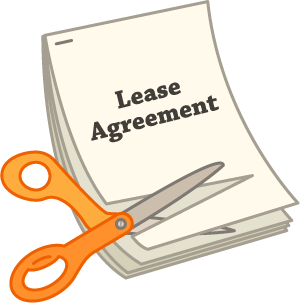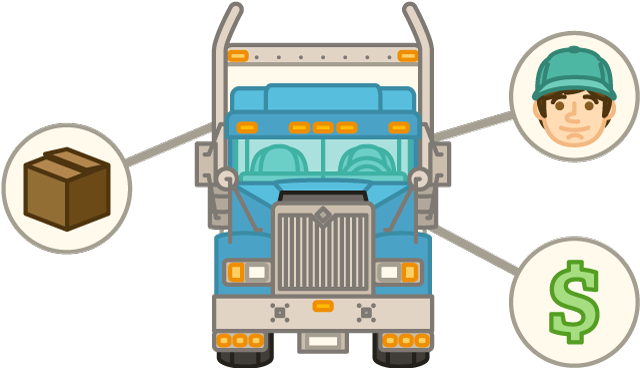
Once the dust settles in your new home and the moving boxes have made their way to the curb, it’s time to get to know your neighbors. Whether you’re a city dweller sharing walls and halls, or you’re in the suburbs splitting a cul-de-sac, the Moveline team believes there’s a huge value in forming relationships with the people who live around you. You don’t have to become BFFs with everyone on your block, but even a casual relationship with one or two neighbors has its benefits.
A good neighbor can be your best ally when it comes to insight and services that only someone who lives close can offer. Aside from arming you with an inside scoop on your new ‘hood, a trusty neighbor can potentially keep an eye on your home or pets while you’re away, lend you equipment and tools to keep your place in working order and be there for support and assistance in case of an emergency. Make good with your neighbors from the start and they’re apt to be more understanding about occasional noise or your bold aesthetic choices.
In case the Welcoming Committee has yet to knock on your door with a peace offering casserole or six-pack, here are our tips for getting to know the people on the other side of the fence.
Make yourself visible
Keep in mind that your living space isn’t limited to what’s inside your front door. Spending time in your building’s common areas or in your front yard will help make your presence known. This also gives your new neighbors an opportunity to approach you with a proper welcome. Shopping locally and attending neighborhood events ensures you’ll run into the right people, so make it a point to make eye contact and say hello to everyone in your path.
Pull the pet card
An easy way to strike up conversation with a new neighbor is through their pet, but dog owners are notorious for bonding over their furry friends amidst a tangle of twisted leashes without getting to know the person behind the pooch. Be sure to learn your neighbor’s name, as well as that of their dog. If you’re also a pet owner, you should use these run-ins as an opportunity to ask about local dog parks or vets, but if you can take the conversation from pup-talk to personal you may just end up with the friend-and-neighbor of your dreams.
Be a sharer
The old sentiment behind borrowing a cup of sugar isn’t lost on us. There is something satisfying and sweet about being able to call on your neighbor in a time of need, and it can work both ways. Next time you bake a batch of cookies, get too much cilantro in your weekly CSA or bring home more flowers than can fit in those window boxes, consider sharing the love by offering the excess to your neighbors.
Throw a party
If space and other logistics allow, there’s no more tried and true way to entice your neighbors into friendship by inviting them to a party at your home. This isn’t the time to be exclusive – make sure the invitation is open to everyone. Even if they’re not the partying type, any neighbor will appreciate feeling included.
Explore Moveline’s tips for making your new place feel like home, and check out other post-move advice. The dirty work may already be done, but we’re still here for you. And if you’re planning a move that hasn’t taken place yet, don’t go it alone. Let us help. It’s what we’re here for, and it’s free.

The weird, wild capital of the Lone Star State is known for a lot of things — music festivals, startup culture, a laid-back vibe and the best BBQ in America, to name a few — and it’s quickly becoming a synonym for “cool place to live” in pop culture references far and wide, from its mention in The Office finale as Jim and Pam’s new home to the fact that countless lists include it among the top 10 places in the nation to hang your (cowboy) hat.
So, why all the fuss? If you’ve visited, you probably understand the hipster haven’s allure… and if you haven’t, perhaps its recent selection as thebest city in the US for the “Young, Broke and Single” will convince you of its cheap/chic grandeur. To wit, the Moveline team has compiled a ten-gallon list of free things to do in Austin.
Enjoy the outdoors
“The stars at night / Are big and bright / Deep in the heart of Texas,” just like the songs says… and truth be told, the views are pretty awesome by day as well. Get your heart rate up by climbing the limestone steps up to Covert Park at Mt. Bonnell, the highest publicly-accessible point in the city, for sweeping photo ops and the perfect spot for a little meditation. Spin your wheels or run the pup around the city’s central body of water via the Lady Bird Lake Hike & Bike Trail (pro tip: it’s referred to as “Town Lake” by the locals).
Catch some rays and play some frisbee golf on the Greenbelt, or cool off by taking a dip in the serene (yet always packed) Barton Springs Pool — thanks to its $3 entry fee, it’s technically not free, but hey…. it’s pretty darn close. Beautiful city parks are a staple of local living, as are copious amounts of sunscreen; there’s no shortage of opportunities to use both all over town.
Get cultured
An arts mecca, Austin prides itself on the constant availability of creative experiences. No fewer than eight museums offer free admission all the time, while The Blanton waives its entry fee every Thursday and the Austin Children’s Museum hosts community nights on Wednesdays with suggested donations of just $1.
The Austin Symphony invites music lovers to hang out under the stars and enjoy live performances every Sunday evening in the summer, while an endless variety of offbeat fun presents itself all year round in the form of burlesque shows, theatrical productions and events that defy definition; check the Austin Chronicle’s events calendar for up-to-the-minute news on what’s fun and free.
Party, party, party
Austin’s signature event — as far as its global audience is concerned, anyway — is most certainlySouth By Southwest, a juggernaut of a festival including the genres of music, film and interactive. Although its badges and wristbands are undeniably pricey, the unofficial SXSW party circuit is as robust as the festival itself. Start canvassing the web a few months early to get on the list for each party that interests you, and once the festival arrives, follow the tweets, texts and Instagrams other events popping up around town with free food, drinks and entertainment. There’s never any shortage of brands (and bands) ready to vie for your loyalty with tacos and beer on the house when the South By machine is in town.
As for the rest of the year, the Live Music Capital of the World is called such for a reason; not a night goes by without a local band (or ten, or twenty) playing somewhere with no cover, just waiting for you to rock out with them.
And of course, if your personal life is more Fraggle Rock than Shiner Bock, the blog “Free Fun in Austin” is a virtual funhouse filled with daily tips on family-friendly things to do without opening your wallet.
Ready to roll like a tumbleweed into the land of tacos and tequila? Check out our guide to finding a sublet in Austin and let us help you make your move. Whether you’re moving to Texas or anywhere else in the US, we’ll assign a Move Captain to help you through the inventory process and secure fair, accurate quotes from reputable moving companies on your behalf. Then, we’ll oversee your move every step of the way to save you the stress. The best part: it’s free. Check out our homepage and let us help you get started with your move today.

Let’s say life’s thrown you a curve ball — be it a great one (a proposal or promotion) or a not-so-great one (an illness, layoff or breakup) — and you need to leave your current apartment, but you’re not sure what your options are. You’re not alone; in fact, most folks don’t read every line of fine print in their rental agreements even though we all know we should. That’s why we’ve decided to shed a little light on the choices that may be available to you in the event you need to split, and fast.
At Moveline, we’ve worked with a variety of people moving for a wide array of reasons, and suffice it to say, we’ve run into the question of how to break a lease more than a few times. So, we’ve put together a helpful list of 5 tactics you can take to get out of your rental contract legally and with as little hassle as possible.
1. Find a termination clause
The first thing to do when you think you may need to break a lease is look for any termination clauses in your lease contract. While most landlords and property managers don’t go over these with any level of detail, it’s probable that termination language is included somewhere on the document. Depending on your reason for vacating, you might be able to get off scot-free with the appropriate amount of notice, given the fact that you lost a job, got transferred at work, had a medical issue or some other circumstance that’s clearly outlined in the clause. If so, be up front with your leasing office and put it in writing. A contract’s a contract, and you should be able to move without consequence.
2. Negotiate, negotiate, negotiate
If there’s not a termination clause, or if your particular situation just isn’t covered by one, it’s possible you can simply talk your way out of your lease. While the odds are slim that you won’t lose your security deposit at best (and perhaps quite a bit more in the worst case scenario), it couldn’t hurt to ask. If the property is in such high demand that there’s a wait list (let’s say you’ve got a rent-controlled unit in a desirable neighborhood in New York City, for example), you just may be in luck with a bit of politeness and some finely-tuned negotiating skills. If not, however, you may still have other options.
3. Find someone to sublet
Subleasing agreements are like snowflakes: it seems no two are truly alike. Check with your leasing office to see if they’ll allow you to sublet in the first place; if not, you’re barking up the wrong tree, but if so, you may be a Craigslist ad away from packing up your stuff. Be sure to review the terms of the subletting clause carefully to see what responsibilities you’ll still have once you’ve moved out and a new renter has moved in under your old contract.
4. Lose the security deposit
If there’s no termination clause that speaks to your circumstances, subletting your place isn’t an option, and no amount of sweet-talking is going to get you out of your lease without penalty, you may still have a bit of negotiating power if you’re willing to spread your remaining fees out over a payment plan. If, say, you’re terminating your lease two months early and genuinely can’t continue to pay the same rent at the same rate once you’ve gone, it’s possible you may be able to split it up into four payments, perhaps through a direct debit arrangement to give the landlord peace of mind that he or she isn’t being taken for a ride. And if you’re lucky, you can get out of your remaining payments altogether and simply lose your entire security deposit (plus cleaning and renovation fees if you leave the place a mess).
5. Take it on the chin
If all else fails, consider using credit cards or whatever means necessary (again: legally, of course!) to pay off your remaining balance once you’ve vacated the space. Simply refusing to pay will set into motion an unpleasant series of events, including stern, intimidating calls and letters from debt collectors — not to mention a considerable blow to your credit score and the potential difficulty of getting approved for a future lease elsewhere. By all means, do what you can to pay your fees in full as quickly as possible and sustain a minimal amount of damage to your financial future.
Regardless of how you’re moving or where, let Moveline help reduce the headache. At no charge to you, we’ll assign you a Move Captain to help you inventory your stuff and get fair, accurate quotes from reputable, licensed movers. Then, we’ll oversee your move every step of the way to make sure it runs as smoothly as possible. So don’t go it alone. Let Moveline help. Start planning your move with us by visiting our homepage and learning more about what we do.

Moving can turn our lives a little sideways, particularly when we’re crossing state lines and time zones. In instances where we’ll likely be away from the majority of our stuff for hours, days or even weeks, it’s critical to have important documents on hand in the event they’ll be needed along the way. And of course, knowing precisely where our records and identification are in times of transition can give us peace of mind even when everything else is on the move. (Just for kicks: do you know where your passport is?)
At Moveline, we’ve seen more than our fair share of moves, and we’ve got plenty of tips for avoiding small mishaps — not to mention keeping small mishaps from becoming big ones.
Here’s a list of documents to keep with you and yours during a move… just in case:
- Driver’s licenses, ATM cards and credit cards
- Passports and visas
- Original or certified copies of birth certificates
- Medical records pertaining to any conditions that could pose a risk during the move
- Kids’ doctors’ numbers written or printed on paper and easily accessible (in a purse or wallet)
- Most recent vet checkup report for pets traveling with you, including all updated vaccination documents
- Vehicle registration records and auto insurance cards
- Lease copies/mortgage documents from both your old and new homes, neatly ordered and accessible
- A list of important phone numbers written down in case, heaven forbid, phones lose juice or go missing
- Business cards, if you make a habit of handing them out regularly
- Checkbooks, if you still use them
As with anything in life, little emergencies can happen at any time, but during a move, since our belongings can be rendered inaccessible for long periods of time, a little planning and preparation can go a long way toward mitigating stress and frustration if things don’t run as smoothly as we’d like. Take a moment a few days (or weeks) before a move to set these documents aside and alleviate headaches before they start.
Wherever your move might take you in the US, let Moveline help. We offer free services to make your move as painless as possible, from simplifying the inventory process to obtaining fair, accurate quotes from reputable movers on your behalf. Let one of our Move Captains oversee the process from start to finish, helping you ease your way from your old home to your new one. Start planning a move on our homepage today.

We’ve all been there: that moment during a move when a third (or fifth, or eighth) trip has to be made to the hardware store, the corner grocery or the 24-hour mart to pick up something — whether it’s more boxes, another roll of tape, or some random thing we never imagined we’d need, but all of a sudden it’s become a necessity. And for some reason (see: “Murphy’s Law”), it always seems to happen in the middle of the night or the moment before the moving truck pulls into the driveway, ready to rock and roll before you are.
To keep that moment from reoccurring, the Moveline team has put together a short and sweet checklist of packing essentials to stock up on before a move. Since we’re moving experts, we’ve got more than a few tips to make a relocation run smoothly, whether it’s a ZIP code away or clear across the country. So, trust us when we say you very likely need the following:
Moving essentials:
- An abundance of regular boxes (obviously, unless the movers are packing for you)
- Eco-friendly rentable boxes, if you want to reduce your move’s environmental impact
- Specialty containers for items you’re concerned about (wine glasses, fine china, family heirlooms)
- Bubble wrap and/or packing paper to protect breakables and stabilize not-quite-full boxes
- More tape than you think you’ll need; you can always use the extra stuff later, in your new home
- More magic markers than you think you’ll need; it’s no picnic when they run dry or get misplaced
- Photos of the back of your computer and TV, where re-attaching wires could otherwise get tricky
- A suitcase with several days’ worth of clothing, depending on how your wardrobe is being moved
- Bottled water for the day of the move (eco-friendly option: a gallon or two, plus reusable cups)
- Portable snacks, since you really shouldn’t run out for grub during loading and unloading
- Items set aside that need to be reachable on moving day (i.e., a “first night box;” see our handy list
- Arrangements made for kids and pets, if at all possible (read our reasons why)
No matter the circumstances of your move, Moveline can help. For free, we demystify the inventory process and get fair, accurate moving quotes from reputable movers on your behalf; better still, we assign you a Move Captain to oversee your entire relocation and make sure it runs smoothly. Moving is stressful enough on its own, so don’t go it alone. Let us help. We’ll remove the headache.

Few topics scream “adulthood” and “commitment” more loudly than real estate, and to put it mildly, the market — and society in general — isn’t what it was 50 years ago. Gone are the days when everyone was expected to get married and invest in a home before completing the first quarter-century of life… and for more reasons than one, perhaps that’s a good thing.
At Moveline, we’ve worked with folks of all ages and backgrounds with all sorts of careers and personal lives, and no two cases are exactly alike. There are some mile markers that signify readiness for real estate investing, though, so we’ve put together a quick guide to help you determine whether or not it might be time for you to buy your first home
Your finances are in fantastic shape
First and foremost, lenders want to be assured that they’ll receive their payments like clockwork — on time and in full. If your credit rating is low, you’re up to your ears in debt, your income is unsteady and/or you’ve only got a tiny bit of money saved up for a rainy day, chances are, you’re not a viable candidate for homeownership right now.
On the other hand, if your financial house is in order, you might be ready to sink some of it into an actual house. Your financial institution can review your profile and determine what kind of loan, if any, you might qualify for, which should help set the parameters for the type of home you’ll be shopping for. Particularly if you’ve built a longstanding relationship with your bank or credit union, you should be able to ask frank questions about exactly what needs to be done to put you in the proper position to invest.
You have realistic expectations
Simply having the remote perenially tuned to HGTV won’t arm you with an accurate set of data when it comes to knowing what homes cost in your city or town (or, for that matter, the place you might be relocating to if you’re considering settling down somewhere else). Do your research through publicly-accessible sites like Zillow and Trulia, and make sure you have a good idea of what a monthly mortgage payment would be with an acceptable mortgage rate over a comfortable period of time.
Also, keep in mind that renovation budgets can inflate quickly, so if you’re looking into fixer-uppers, be sure to do your homework on the potential amount you might be dropping on those floors, that yard, those pipes and whatever else might need to change in that house with “good bones” and “lots of potential.”. Remember, real estate professionals need to make a sale off of you, so an agent might not be the best person to ask for advice in the beginning of your planning process; again, your financial institution should have qualified staff ready to walk you through any questions you might have about the first-time homebuyer process — particularly when it comes to your cash. And of course, there’s no shortage of online resources for buying a home.
You can make a sizeable down payment
Speaking of cash, a large down payment can obviously save you a world of hurt on a monthly mortgage payment and potentially give you more power during the purchasing process. If your credit is healthy, your debts are minimal to nonexistent, and you’re mentally prepared to purchase a home but don’t quite have a comfortable amount of money saved for a down payment, organizations like Kiplinger’s offer great guides and worksheets on saving moneytoward large purchases like a home.
You really, really want to settle down
More than anything, purchasing a home is a big deal, emotionally as well as financially. With more than a solid 35 percent of the American population renting, The Atlantic Cities reports that three in five adults in the U.S. believe that “renters can be just as successful as homeowners in achieving the American Dream.” So be sure that if you’re indeed thinking of buying a home, you’re doing it for your own gratification and not to appease anyone else, like parents, co-workers or that secret nemesis you’ve been silently competing with since high school.
The emotional, fiscal and physical commitment of buying a home — particularly for the first time — is nothing to be taken lightly; while it’s certainly something to be celebrated, it’s not something to be done on a whim. Do your homework, take your time, and make sure you’re properly motivated and prepared to spend a good deal of time and energy on making your next home officially yours.
Whether you’ll be renting or owning your next home, let Moveline help with the moving process. By simplifying your inventory process and assigning a Move Captain to secure fair,accurate quotes from reputable moving companies on your behalf, we’ll oversee the entire process and take the headache out of ot completely. Best of all, our services are free. So don’t go it alone. Let Moveline help you #movebetter. Get started on our homepage to learn how we can make life easier during your next transition.

Here at Moveline, we’ve overseen quite a few moves — down the street, across the country and everything in between. Undoubtedly, moving with young kids in tow carries a special set of challenges and considerations, but with a little pre-planning, it can be an adventure instead of a debacle.
Check out this video of a sweet couple, Corey and Emily, whom we helped move to Las Vegas with a four year-old and a one year-old in tow. The takeaway: remembering little things like nap schedules and feeding times can make all the difference in the world when it comes to getting a family from point A to point B without losing any sanity in the process.
If you’re moving sometime soon — kids or no kids — let Moveline give you a hand. We specialize in getting you the best deal possible from reputable movers and overseeing your move every step of the way. The best part: it’s free — just like all the best things in life. So don’t go it alone. Let Moveline help. Visit our homepage to start planning your move, hassle-free.

Step back in time
If you don’t mind spending some time getting everything “just so,” you’re likely in for a treat: there’s certainly no shortage of secondhand stores and flea markets in even the most suburban and rural of neighborhoods. While the most truly impressive clusters of vintage shops are typically found in places like New York, San Francisco, Seattle and Austin, don’t underestimate the power of a little ingenuity and patience. Flea markets and estate sales can fill your Saturdays with treasure-hunting adventures as you decorate your space with discounted goods. And of course, online resources like good ol’ Craigslist make budget-minded shopping excursions possible from the comfort of your couch.
If you’re too short on time or patience for Craigslist fails and don’t want to make a sport out of personally perusing antiques and lightly-used home accents, never fear; our friends at Apartment Therapy have plenty of online vintage shopping suggestions for your casa. (Ah, the interwebs… how we love you.)
Get creative
When decorating your space, less can be more, and it’s not necessary to go overboard, filling every nook and cranny with decoration. Just a few thoughtfully arranged touches — well-placed candles in a fireplace you don’t use, personal photographs artfully tacked to a wall in a cool pattern, or even simple paper lanterns strategically hung from a corner of the room — can provide more warmth and character than any expensive designer pillows ever could. Ask any truly creative designer about great use of space, and each one should agree: the greatest way to decorate a space is to let its inhabitants’ personality shine through, loud and clear. And that rarely means deep pockets; it often means ingenuity, like you’ll find here, here and here.
Show your true colors
Maybe you’re the get-it-over-and-done-with-quick type — someone to whom the sentimentality of objects doesn’t really apply. By far, the most straightforward way to impact the look of a home is to use color in big, bold ways — and the simplest way to apply lots of color without lots of time spent mulling over fabrics, knickknacks and tchotchkes is to paint the walls. And the biggest money saver of all in this scenario: putting on some sweatpants, rolling up your shirtsleeves and doing the work yourself.
Pick a different color for each room, or choose one color for the central living space and one separate color for the rest of the apartment (with the landlord’s blessing, of course, or at least the knowledge that you’ll be painting right back over it before you move out if you want to see your security deposit again). For greatest results, leave baseboards, doors and chair railings (if you have them) off-white for a classic contrast. And don’t forget the painter’s tape and drop cloths — they’re essential.
Chalk it up
If you’re particularly artistic or just love a good bit of nostalgia, chalkboard paint is a fun and affordable way to cover your walls (okay, perhaps not all of them — maybe just one or two), leaving open an endless array of options for decor; you can write a favorite quote in huge chalk letters one month and spend the next filling the room with doodles, or notes to yourself, or a non-stop game of tic-tac-toe with roommates. All it takes is a few cans of Rustoleum from the local hardware store and you’re good to go.
Inspired? Want more? Check out the Moveline blog archives for more budget-friendly ideas on making a rental feel like home. And if you’re moving in the near future, let Moveline help. By taking the reins, getting quotes on your behalf and overseeing your entire move, we take the stress and headache out of the process entirely — for free. So don’t go it alone. Partner up with us and make your move easier than you ever imagined.

Planning a move but overwhelmed at the prospect of hiring the right mover at the right price? You’re not alone. The U.S. Census bureau estimates that, each year, about 12 percent of the country’s population moves — that’s more than 30 million people relocating from one home to another in the next 12 months. Needless to say, while movers want your business, if you don’t know your rights and use the resources that are available to you, it’s not likely you’ll get the best possible deal. Since knowledge is power, we’re arming you with a smart, quick rundown on choosing a mover that’s right for you.
Understand that timing is everything
The moving industry is a fast-paced, mileage-accruing mega-machine, relocating up to 12 percent of the U.S. population each year. That’s an awful lot of people, so imagine the extra work and expense required to accommodate last-minute requests — particularly where cross-country moves are concerned.
For the best rates and greatest amount of options, start your planning process early — several months is ideal — and free yourself up for the opportunity to work with whatever mover you choose, rather than letting your last-minute circumstances choose for you.
Get fair, accurate quotes
The inventory process is a make-it-or-break-it element of any moving budget. While you may estimate, for example, that you need 30 boxes and a couple hours of professional movers’ time to get the job done, that super-affordable-sounding quote won’t be so super if you ultimately wind up needing 60 boxes and twice as many hours of moving time. In fact, the cost can more than double over a simple, honest miscalculation.
That’s one of the many reasons we founded Moveline — to take the guesswork out of moving and save everyone a little sanity. We’ve developed special software to demystify the inventory process and obtain reasonable, relevant quotes that won’t change (i.e., spike) when moving day finally arrives. Take a spin through our homepage and watch our short video to learn about our Move Captains, our use of video to avoid in-person consultations with movers, and the general process of working with Moveline.
Know your rights & responsibilities
First and foremost when it comes to moving, while the customer may always be right in theory, the law can sometimes state otherwise. The good news is, learning your rights doesn’t have to be a murky process.
Although moving companies are require to share a rights & responsibilities booklet with you (published by the US Department of Transportation), you don’t have to wait on them; you can read it beforehand and get familiar with the basics of movers’ rights.
Don’t get swindled
Although Moveline is free for customers, should you choose to go it alone, be sure to check out the Federal Motor Carrier Safety Administration’s tips for choosing a reputable mover.
Most importantly, make sure you work with a company that’s licensed by the proper authority: for state-to-state moves, the FMCSA is the licensing authority, while within an individual state, licensors vary. And although it may seem a bit overwhelming, this comprehensive glossary of moving terminology may come in handy, too.
Whether your move is just a few streets over or all the way from one coast to another, Moveline can help. Praised by The New York Times, Forbes, Lifehacker, TechCrunch and more, we take the headache out of moving by acting on our customers’ behalf to get fair, accurate quotes and oversee a seamless, hassle-free moving process. Don’t go it alone — let us lend a hand and help you #movebetter.

It’s the stuff of songs and slogans, and according to advertisers and bachelor party attendees, what happens there stays there, although Hollywood might respectfully disagree. Las Vegas may be known as a convention capital, a party city and a glitzy (albeit manmade) retreat full of wonder, but from what we hear, it’s not a bad place to live. Permanently.
At Moveline, we’ve overseen a lot of moves, from couples moving during a hurricane to families making a cross-country move with kids in tow, and we’ve got all sorts of insight to share about each city we’ve experienced. So today, take a gander at our list of the top 5 reasons to move to Vegas.
1. It’s startup-friendly
An innovative endeavor called Downtown Project seeks to make downtown Las Vegas a veritable hub for startups within the next five years. Sinking an impressive $350 million revitalization budget into the area, its plans include lending hefty support to real estate development, small business ventures, tech startups, co-working spaces and local education, making downtown Vegas a perfect place to launch and grow a new business — even while raising a family.
2. It’s not expensive
While the cost of coffee may be oddly higher there than some parts of the country, the overallcost of living in Vegas is actually less than the national average… not bad for a city as well-known as this bustling desert oasis. Fun facts: pizza in Vegas is 11 percent cheaper than the national average, gas is 4 percent less expensive, and housing/utilities are each 8-10 percent less than the average American city or town. The lack of state income tax, too, is often a welcome break for new residents.
3. It’s not cold & wet
For those to whom Seattle, for instance, sounds like a nightmare, Las Vegas is likely the perfect antidote. Claiming 300+ days of sunshine a year, the city is located smack in the center of Vegas Valley, a desert spanning about 600 square miles. With an annual average of 67 degrees (rarely climbing above 91 in the summer or dipping below 45 in the winter), folks who aren’t fans of extremes are all about the temperate climate.
4. It’s entertaining
“Viva Las Vegas!” exclaimed the King, and for good reason: consider all the sensory distractions at your fingertips when you live in the self-proclaimed “Entertainment Capital of the World.” A performance-goer’s paradise, there’s never any shortage of stage shows, bars, casinos and all-you-can-eat buffets within a stone’s throw. So even if your day job’s not that thrilling, there’s no shortage of weekend fun to take your mind off of the mundane. And who knows — even though The Hangover movies have all officially wrapped, you might luck out and run into this guy wandering around memory lane sometime.
5. It’s got great neighbors
Speaking of weekends, when Sin City residents need a bit of detox, the city’s only a road trip away from a bevy of nearby destinations. Los Angeles, San Diego and Phoenix are all a four- or five-hour drive away, as are a host of outdoor vacation spots like Death Valley and Red Rock Canyon, not far at all from the bright lights of the strip.
If you’re planning a move to Vegas — or anywhere else in the US, for that matter — let Moveline help. By demystifying the inventory process and obtaining fair quotes from reputable movers, our Move Captains take the headache out of moving and let you focus on the more important things in life — and the best part is, it’s free. Let us help you #movebetter.